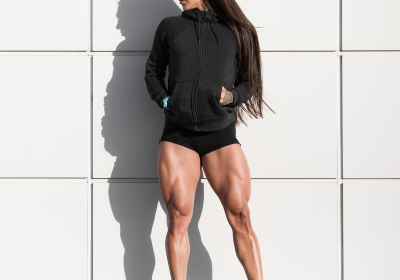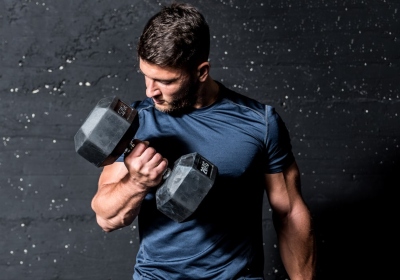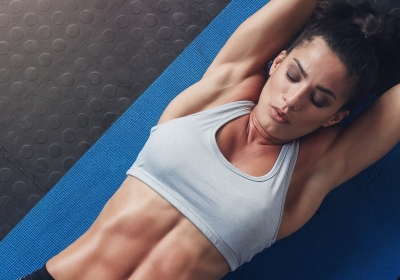VIDEO
Sit-Throughs
- Core
- Biceps
- Lower Back
- Shoulders
- Gluteus
- Quads
Level:Intermediate
Trainer:Nick Taylor
Equipment:No Equipment
Sit-Throughs
- Core
- Biceps
- Lower Back
- Shoulders
- Gluteus
- Quads
Level:Intermediate
Trainer:Nick Taylor
Equipment:No Equipment
Start with your hands and toes on the ground. Knees should be bent and your calves parallel to the floor. Don't raise your butt up, keep it down. From this position rotate onto the left hand and raise the right hand up. Make a kick through with your left leg. Then bring it back, return to the starting position and repeat to the other side.
save to ...
RECOMMENDED FOR YOU
ARTICLES
One of the most important running muscles is the quadriceps - the large muscle at the front of the thigh. It has been scientifically proven that regular strength training improves workout performance and reduces the risk of injury, as well as strengthens your back, and leg muscles, making your running more productive.
The quads, also known as the quadriceps muscle, is a group of muscles located at the front of the leg above the knee. It is one of the largest and strongest muscles in your body that consists of four heads: fastus medialis (medial wide), vastus intermedius (intermediate wide), vastus lateralis (lateral), and rectus femoris (straight thigh muscle). Almost every action performed by the legs involves two or more heads of the quadriceps. The quadriceps muscle plays an important role at the beginning of the movement (quick start) and during ascent and descent in elevated positions - which is why you may experience painful sensations in this area of the leg after an intense uphill workout.
According to researchers at the University of Delaware, strong quadriceps act as cushioning and can protect the knees and the entire musculature of the hip from common running injuries. Often many runners are injured because they have weak and underdeveloped quadriceps, so it is especially important to strengthen them.
By training and strengthening the quads, you can get the following benefits when running:
Increased speed. Strong quadriceps help you tackle steep hills and climbs more easily and make pushing off the ground more powerful, resulting in increased speed.
Reduced injuries. According to research, poorly developed quadriceps are often associated with many running injuries. For example, a common injury such as the 'runner`s knee' results from weakness in these muscles, which are unable to stabilize the knee joint during the movement.
Increased endurance. Strengthening the quadriceps muscle will make your running more effortless and efficient, which contributes to increased running volume and endurance.
Training
The quadriceps occupy 70% of the muscle mass of the leg, so it is their development that is fundamental in leg training. The main exercise for developing the quadriceps is the squat. But, for beginners, at the first stages of training, it is better to start with leg curls sitting in an exercise machine, leg press, and hyperextensions to strengthen the lower back, to avoid injuries, in order to prepare the base for the heavy squats. It is a good idea to include squats in your training plan after about six months of training.
Read more
Biceps is the most famous muscle in the human muscular system, it is approximately one-third of the mass of the shoulder. It is a part of a group of three in the upper arm that works together with each other to lift the arm toward the shoulder. As one of the most visible and impressive parts of the body, “two-headed muscles” are often the gym’s focus.
It is responsible for two main movements of the arm. The first is raising your hand. Those who carry something using their arm are likely to engage them in the process, as some upward force must be applied during the process of carrying and lifting. The second movement, for which they are responsible, is called supination, which rotates the arm from the natural position of the palm down to the palm up.
Biceps are built as a result of injury, which is often achieved through lifting weights such as curls or other types of exercises. As the curls or other exercises are done, the muscles in the arm get minor injuries. These injuries must be repaired naturally. The recovery process, as a natural byproduct, usually leads to growth and strength gains, although this process can take several weeks or months before noticeable results are seen.
Very few exercises work for it without affecting the other parts of the shoulder. Therefore, there is no reason to worry that others in the upper arm might be neglected by focusing on them. Some may focus only on the arm and almost completely forget about the legs or the core.
As one of the most commonly used muscles in the body, the biceps can certainly be damaged. Biceps injuries are not as common as some other types of injuries, there is always a risk, especially among weightlifters. The most common type of injury is damage to the tendon. In this type of injury, It is pulled away from the tendon that attaches it to the arm in a bone also known as the radius. Such injuries occur when they are used suddenly or to a level that they cannot handle.
Training.
Dumbbell Bicep Curls. Stand straight with the dumbbell in each hand and with your feet shoulder-width apart. Once the dumbbells are at your shoulder level, start slowly lower your arms to the starting position. Repeat for the desired amount of repetitions.
Incline Pushup. Place your hands slightly wider than shoulder-width apart on a bench, chair, or couch. And assume a high plank position with your feet together and your body straight from head to heels. Keeping your feet flat and core engaged lower your chest to the bench or chair. Pause. And then push yourself back up to the starting position.
Diamond Knee Pushup. With your knees on the ground place your hands on the ground with your fingers and thumbs touching together creating the diamond shape. This action will engage more your tricep muscle. Then complete a push-up and get back to the starting position. Repeat for the desired number of repetitions.
Pike Pushup. Assume a shorter push-up position, get on your toes and put your butt up, shifting your weights to the front. Bending your arms slowly lower your head, be sure not to bump your head on the ground.
Read more
To work out the perfect buttocks, you need to know what functions they have. In this article, you may read everything about the structure and functions of the gluteus muscles. So, let’s start examining the glutes right now!
First things first, you need to know that glutes consist of three separate parts: large, medium, and small. Accordingly, the functions of the glutes reflect a combination of the functions of these three muscles, and if any of the muscles are not used, then we lack some of them, and, as a result, we do not get the desired look of the buttocks. Probably, it is time to have a closer look at every glute muscle.
The gluteus maximus is the largest of this group of muscles and can reach the thickness of 2-3 cm. It has a rhomboidal shape and almost completely o covers the middle and small gluteus maximus, being on top. In fact, it is this muscle that we usually associate with the considered area of the body that creates the main visible volume.
Here are the main functions of the gluteus maximus:
maintains the position of the torso when the person is standing
assists in extension of the torso after bending over
rotates the hip outward
acts in hip extension.
This muscle is very active during stair climbing and different types of stepping on an elevated surface. It is involved as soon as you change from stepping to running. It is active during upward jumps and various pushing movements of the legs. Besides, the gluteus maximus works together with other muscles in squats and all exercises involving the extension of the thigh and torso.
The middle gluteal muscle (lat. musculus gluteus medius) has a triangle-like shape. It is located under the gluteus maximus but is visible from behind and the side.
The main functions of the middle gluteus muscle are:
extends the hip to the side
participates in the inward and outward rotation of the hip
participates in the torso straightening
And the last, but no less important is the gluteus minimus. This muscle is not visible from the outside because it is the deepest of all three muscles and is completely overlapped by the gluteus medius and gluteus maximus. The shape of the small gluteus maximus resembles the middle gluteus maximus, but it is thinner.
In fact, the functions of this muscle are almost similar to that of the gluteus medius, and they usually work in tandem to create a beautiful shape of your buttocks.
If you are working out your entire body in one workout, do it at least three times a week. Choose one exercise for your gluteus and incorporate it into your program. To avoid stagnation, change exercises after 1-2 workouts.
If you prefer splits, choose 1-2 movements and do it on your leg workout day. Keep in mind that most glute exercises also load the muscles of the posterior surface of the thigh. So if you want to do a heavy deadlift or leg press in a machine, it is better to start with them. Otherwise, the muscles will get tired and you will not be able to work out fully.
We hope that you know more about your glutes right now and your workout will be more effective! Have a nice shape, dear friend.
Read more
The core is a series of muscles that start under the pectoral and extend to the pelvis. It also includes several groups in the back and other groups throughout the torso. A 'strong back' means a good physique and a healthy body. If you want to learn how to do this, learn to exercise at home or at the gym. Once you have achieved this strength, you can also learn to maintain it.
The midsection is the area of the body often referred to as the core and it involves everything in that area including the front, back and sides. It includes:
lower back.
the traverse abdominis (TVA);
erector spinae;
obliques;
If they are week it could cause lower back and waist pain. However, taking care of them can keep your posture healthy and make you stronger in other exercises like running and walking.
Training. One of the best core exercises is a plank. It provides minimal movement but maximal effort, demanding you to support your body on your hands and toes during holding your body in a straight line from your shoulders to your ankles. Also, you can rest on your knees If you need it or make it more difficult by extending your arms so you’re supported by your hands.
Bridge. Lie down on the floor. Put your arms straight down on the floor near your hips. Bend your knees. Lift your hips up and down.
Superman. Do a little push-up. Lie with your face down and stretch and arms forward and your legs backward.
V-Jumps. Sit on a bench or chair, lift your legs, tilt the core slightly forward so that your body forms a 45-degree angle. From this position jump up extending your hands above your head.
Pushup Variation. Put your hands and toes on the mat. Keep your arms straight, but don't lock your elbows. Align your feet making the straight line with your arms. Inhaling, lower your chest to the ground slowly. Straighten your arms to lift your core up, exhaling.
Inchworm Variation. Put your hands on the ground and your feet - on the elevated surface (a bench). Start walking your hands out, as far as you can keeping your legs straight throughout the movement. Make a pause. Walk your hands back up to the starting position.
Reverse Crunches Variation. Bend your legs at the knees and brace your abs to slowly raise your legs so that your knees are directly over your hips. Brace abs and hold the neutral spine position with a slight neutral curve in the lower back. Exhale as you contract the abs Your head should be kept straight and relaxed on the mat. Inhale and slowly return to the starting position.
Read more
The shoulder muscles are divided into two groups. The anterior group consists of flexors: the coracohumeral, the brachialis, and the biceps brachii. The posterior group includes the extensors: the triceps brachii and ulnar.
The coracohumerals start from the coracoid process of the scapula fuses with the short head of the biceps brachii and pectoralis minor and attaches to the humerus at the level of the upper edge of the brachial.
The brachials start from the lower half of the anterior surface of the humerus and the intermuscular septa of the shoulder and attach to the tuberosity of the ulna and its coronal process.
The biceps brachii has two heads starting on the scapula from the supra-articular tubercle (long head) and the coracoid process (short head). It attaches to the forearm to the tuberosity of the radius and the fascia of the forearm. It belongs to the bicarticular part. Concerning the shoulder joint, the biceps of the shoulder is the flexor of the shoulder, and the elbow is the flexor and instep support of the forearm.
The triceps brachii is located on the back of the shoulder, has three heads, and is a bicarticular. It participates in the movements of both the shoulder and the forearm, causing extension and adduction in the shoulder joint and extension in the elbow.
The ulnar starts from the lateral epicondyle of the humerus and radial collateral ligament and the fascia; it is attached to the upper part of the posterior surface and partly to the olecranon of the ulna in its upper quarter. The function of this is to extend the forearm.
The bundles of the deltoid muscle perform different functions, so it will not work to load them all with one exercise: you will have to include at least three movements in the training. All exercises are divided into three parts: for pumping the front, middle and back beams. Pick exercises from our list below and add them to your workouts. The weight is necessary so that the last repetitions in the approach are given not easily, but without compromising the technique. You can train your shoulder straps both at home and in the gym. But it is necessary to have a bar and a gantry. Weight must be chosen in such a way that in every set it was possible to raise the average 8-10 times. This is how you can increase the volume and mass. If the same goal is set - to increase the strength, to train in the face of more severe conditions. In this case, the number of repeats will be 5-8. The number of reps is 4-5.
Barbell bench press. Take the shell on your chest, bring your elbows forward, tighten your abs, buttocks, legs. Squeeze the bar up, lower it back and repeat. When the bar passes your face, do not lift your chin, but squeeze it in yourself: this way the bar will go along the optimal trajectory. If the projectile remains in front of the body at the top point, and not above it, the load on the lower back increases. Therefore, try to take the barbell behind your head.
Standing dumbbell press. Raise your arms with the selected weight to shoulder level, turn your palms forward with your fingers. Squeeze the dumbbells up and take them slightly behind your head, and then lower them to the starting position and repeat. Do three to five approaches 10-12 times.
Seated Bent-Over Dumbbell Routing. Sit on a bench, tilt your body with a straight back, as far as flexibility allows, hold the dumbbells in your lowered hands. Without changing the position of the body, spread your arms with the taken weight on the sides to shoulder level. Slowly lower the dumbbells to the starting position and repeat.
Read more
SAVE TO ...





